
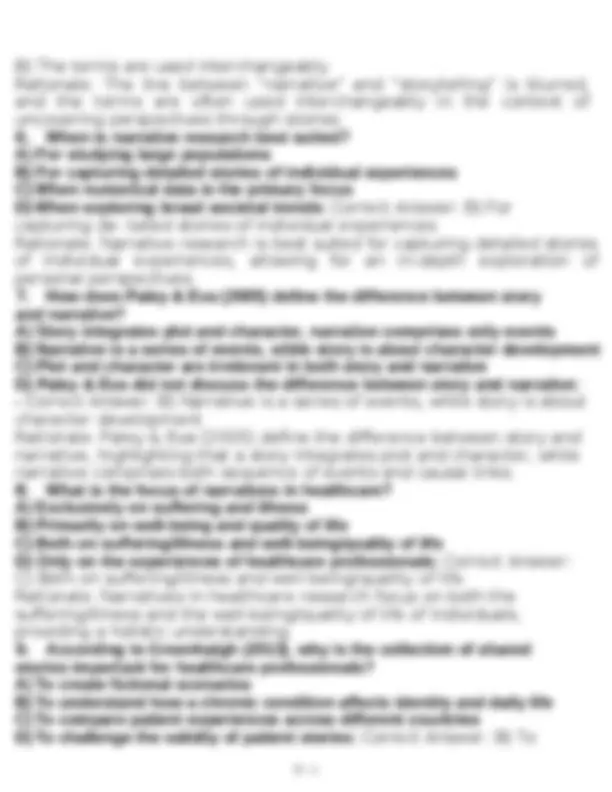

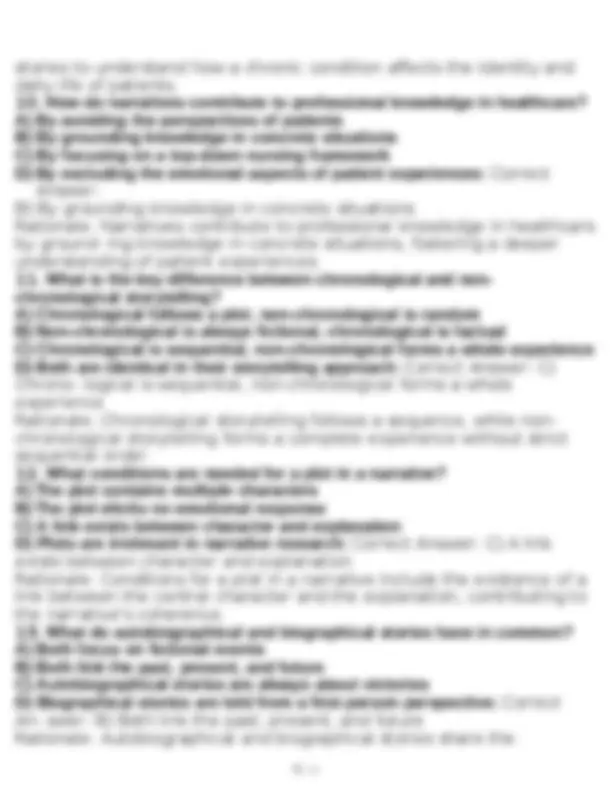

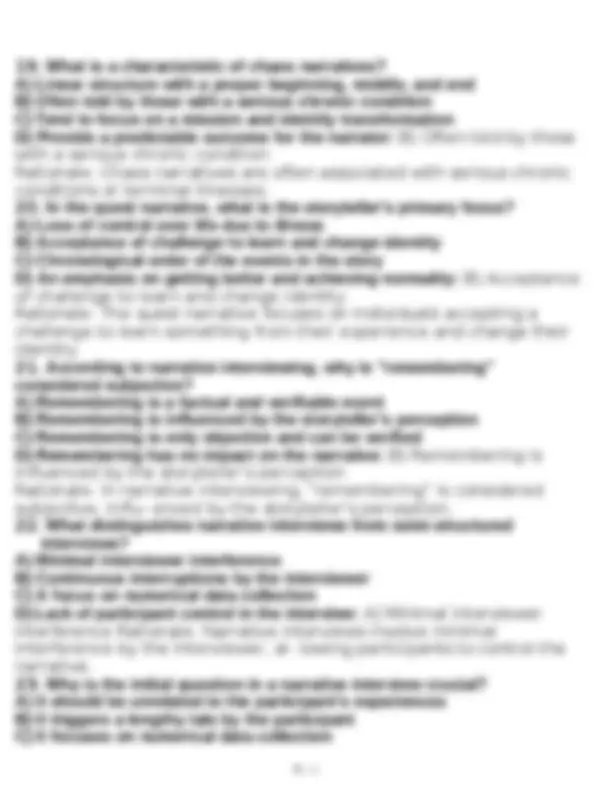

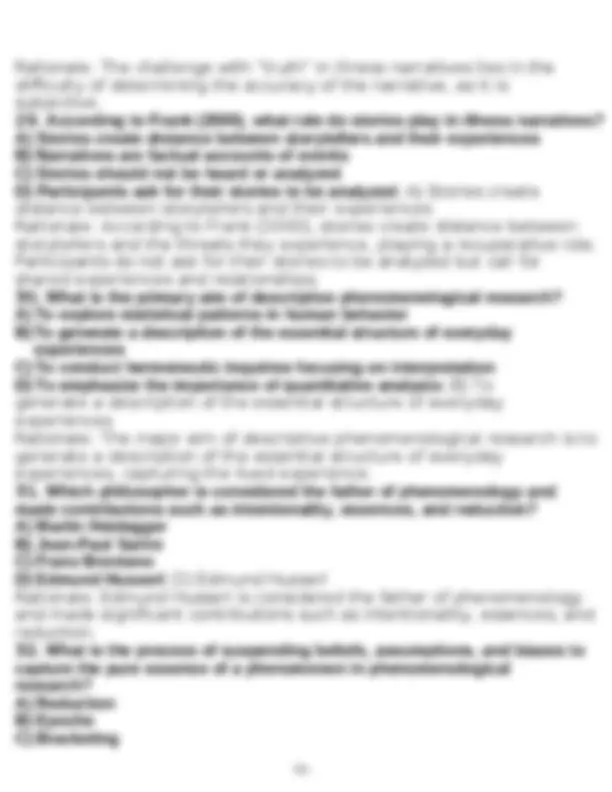

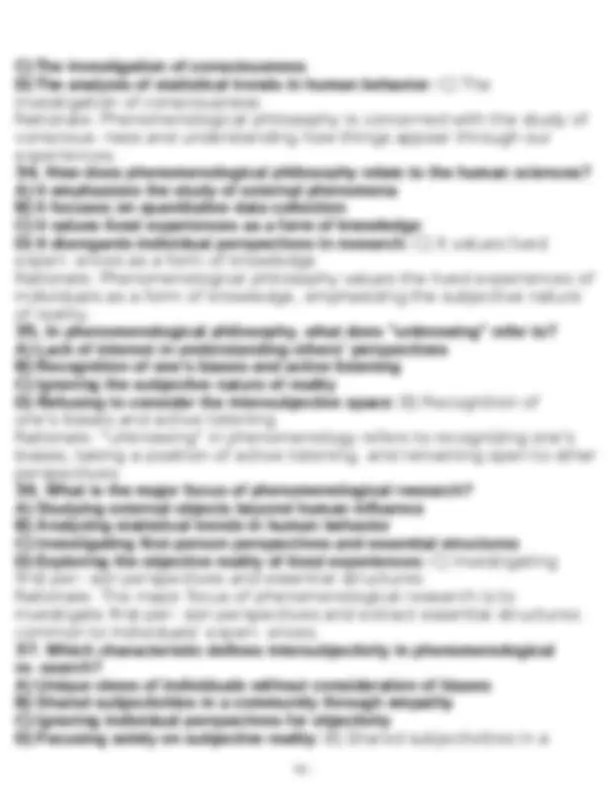

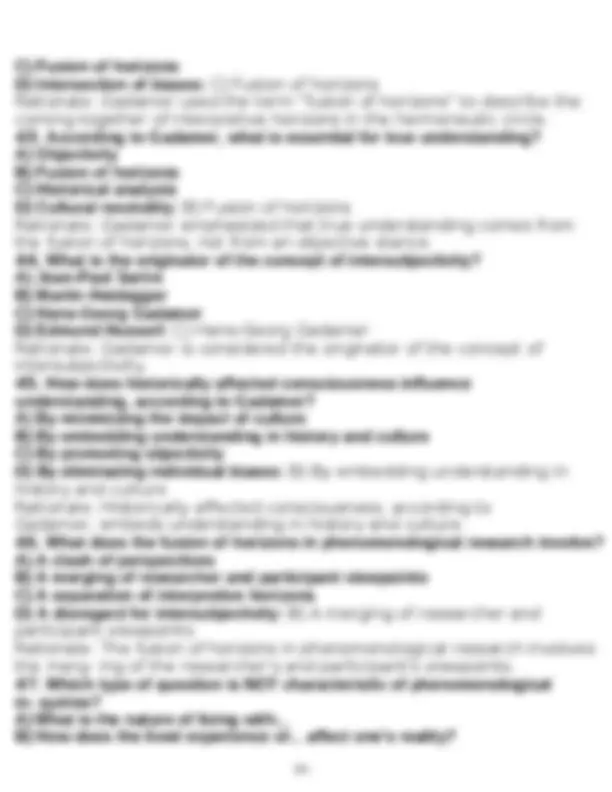

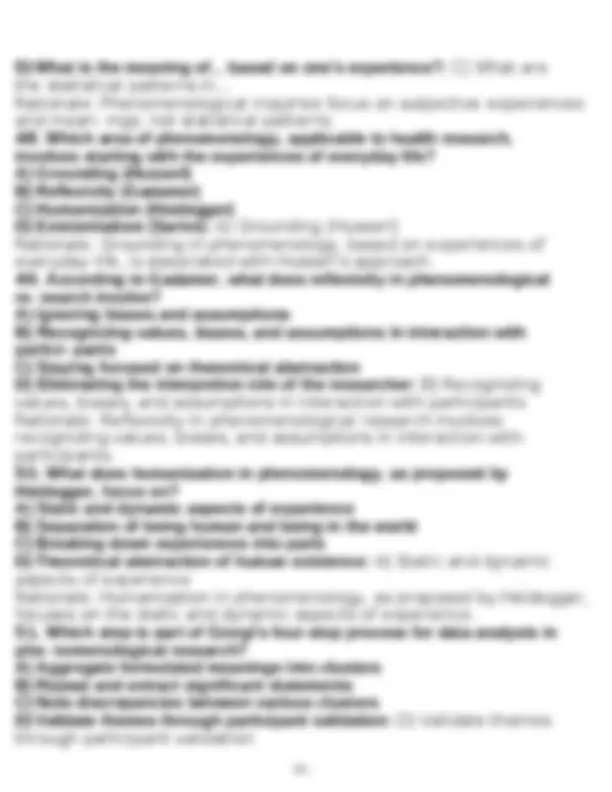
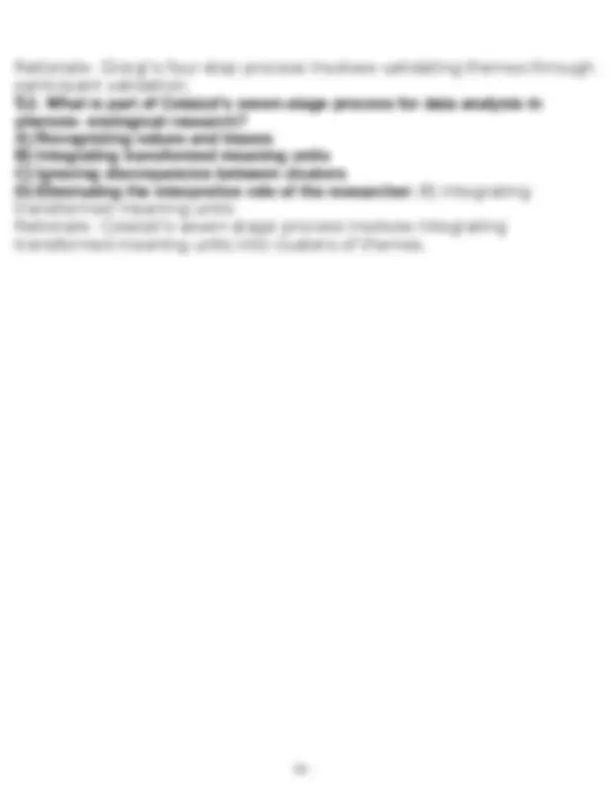


Study with the several resources on Docsity

Earn points by helping other students or get them with a premium plan


Prepare for your exams
Study with the several resources on Docsity

Earn points to download
Earn points by helping other students or get them with a premium plan
Community
Ask the community for help and clear up your study doubts
Discover the best universities in your country according to Docsity users
Free resources
Download our free guides on studying techniques, anxiety management strategies, and thesis advice from Docsity tutors
Narrative research is a qualitative approach that focuses on understanding individuals' lived experiences through the stories they tell. It explores key characteristics, such as 'turning points' in narratives, the relationship between stories and narratives, and the role of cultural stories in providing context. The document also discusses the significance of collective stories in healthcare research, different types of illness narratives, and the challenges associated with the concept of 'truth' in these narratives. Additionally, it delves into the principles of phenomenological research, including its primary aim, the focus on first-person perspectives, and the purpose of the hermeneutic circle. This overview provides valuable insights into the methodological approaches and applications of narrative and phenomenological research.
Typology: Exercises
1 / 22

This page cannot be seen from the preview
Don't miss anything!















NURS 3031 Qualitative Research Week 4 Questions With Answers
1. What is a key characteristic of narrative research? A) Collecting numerical data B) Shaping stories into a chronological order C) Focusing on statistical analysis D) Ignoring the context of the stories: Correct Answer: B) Shaping stories into a chronological order Rationale: Narrative research involves shaping stories into a chronological order to understand the sequence of events and their significance. 2. Why are "turning points" important in narrative research? A) They add drama to the stories B) They indicate shifts in the narrative C) They are irrelevant to the research D) They determine the length of the narrative: Correct Answer: B) They indicate shifts in the narrative Rationale: "Turning points" in narratives are crucial as they signify key shifts or changes in the storyline, providing depth and meaning. 3. In narrative research, where do stories typically occur? A) Any random place B) Within a specific context C) In a controlled environment D) Across multiple countries: Correct Answer: B) Within a specific context Rationale: Stories in narrative research occur within a specific context, emphasizing the importance of understanding the setting for a comprehensive analysis. 4. According to Frank (1995), how are stories and narratives related? A) Stories are standalone, while narratives encompass several stories B) Narratives focus on numerical data, while stories focus on experiences C) Stories and narratives are interchangeable terms D) Frank did not discuss the relationship between stories and narratives: Cor- rect Answer: A) Stories are standalone, while narratives encompass several stories Rationale: Frank (1995) suggests that stories are tales people tell, while narratives encompass a general structure that includes multiple stories.
5. What is the blurred line between "narrative" and "storytelling"? A) Stories focus on individuals, while narratives focus on groups B) The terms are used interchangeably C) Narrative is more specific and factual than storytelling D) Storytelling is always fictional, while narratives are factual: Correct Answer:
understand how a chronic condition affects identity and daily life Rationale: Greenhalgh (2013) emphasizes the importance of collecting shared
stories to understand how a chronic condition affects the identity and daily life of patients.
10. How do narratives contribute to professional knowledge in healthcare? A) By avoiding the perspectives of patients B) By grounding knowledge in concrete situations C) By focusing on a top-down nursing framework D) By excluding the emotional aspects of patient experiences: Correct Answer: B) By grounding knowledge in concrete situations Rationale: Narratives contribute to professional knowledge in healthcare by ground- ing knowledge in concrete situations, fostering a deeper understanding of patient experiences. 11. What is the key difference between chronological and non- chronological storytelling? A) Chronological follows a plot, non-chronological is random B) Non-chronological is always fictional, chronological is factual C) Chronological is sequential, non-chronological forms a whole experience D) Both are identical in their storytelling approach: Correct Answer: C) Chrono- logical is sequential, non-chronological forms a whole experience Rationale: Chronological storytelling follows a sequence, while non- chronological storytelling forms a complete experience without strict sequential order. 12. What conditions are needed for a plot in a narrative? A) The plot contains multiple characters B) The plot elicits no emotional response C) A link exists between character and explanation D) Plots are irrelevant in narrative research: Correct Answer: C) A link exists between character and explanation Rationale: Conditions for a plot in a narrative include the existence of a link between the central character and the explanation, contributing to the narrative's coherence. 13. What do autobiographical and biographical stories have in common? A) Both focus on fictional events B) Both link the past, present, and future C) Autobiographical stories are always about victories D) Biographical stories are told from a first-person perspective: Correct An- swer: B) Both link the past, present, and future Rationale: Autobiographical and biographical stories share the
contexts C) Cultural stories are irrelevant in healthcare research D) Cultural stories are only focused on fictional scenarios: Correct Answer: B) They heighten awareness and demonstrate meaning in specific cultural contexts Rationale: Cultural stories contribute by heightening awareness and illustrating the meaning of events in specific cultural contexts, aiding in understanding.
15. What is the significance of collective stories in healthcare research? A) They have no impact on understanding patient experiences B) They create a whole picture of individual experiences C) Collective stories are only told by healthcare professionals D) Individual stories are more valuable than collective stories: Correct Answer: B) They create a whole picture of individual experiences Rationale: Collective stories in healthcare research create a comprehensive picture of experiences within a group, providing valuable insights and patterns. 16. According to Paley & Eva, what is the concept of truth in illness narratives? A) Factual truth is crucial, focusing on accuracy B) Truth lies in the interpretation and meaning of the story C) Factual truth is irrelevant, emphasizing meaning and interpretation D) Truth is subjective and varies among different cultures: B) Truth lies in the interpretation and meaning of the story Rationale: According to Paley & Eva, the concept of truth in illness narratives is tied to the interpretation and meaning of the story. 17. Which form of illness narrative is typically associated with the Parsons "sick role" in Western culture? A) Restitution B) Chaos C) Quest D) Combination of all three forms: A) Restitution Rationale: The restitution narrative is typically associated with the Parsons "sick role" in Western culture. 18. How does the restitution narrative align with the machine model? A) The machine model suggests a lack of control over the body B) It implies individuals have control over their bodies and minds C) The machine model focuses on chaos and unpredictability D) Restitution narratives deny the concept of getting better: B) It implies
indi- viduals have control over their bodies and minds Rationale: The restitution narrative aligns with the machine model, suggesting indi- viduals have control over their bodies and minds.
D) It avoids familiarity and experiential topics: B) It triggers a lengthy tale by the participant
Rationale: The initial question in a narrative interview should trigger a lengthy tale from the participant to capture their experiences.
24. What is the primary focus of thematic analysis in narrative research? A) Breaking down the story into pieces B) Analyzing the narrative as a whole C) Identifying patterns in the data D) Maintaining the story's coherence: B) Analyzing the narrative as a whole Rationale: Thematic analysis in narrative research focuses on analyzing the narra- tive as a whole, identifying main statements reflecting the core of the experience. 25. In structured analysis, what elements of the narrative does it focus on? A) The contents and meanings of the story B) How the story is being built up to a climax C) The chronological order of events in the story D) The structural foundation and form of the narrative: B) How the story is being built up to a climax Rationale: Structured analysis focuses on the nature of telling the story itself, including how the story is built up to a climax. 26. What distinguishes dialogical/performance analysis in narrative research? A) Focus on the thematic essence of the story B) Analysis of the narrative as a whole C) Attention to the interactive talk and context D) Breaking down the story into categories: C) Attention to the interactive talk and context Rationale: Dialogical/performance analysis focuses on the social interaction, rela- tionships, and identities co-constructed within the narrative context. 27. Why is visual analysis relevant in narrative research? A) It focuses on numerical data collection B) It involves analyzing visual elements like images and film C) It disregards the context of the narrative D) It separates the story into pieces for analysis: B) It involves analyzing visual elements like images and film Rationale: Visual analysis in narrative research focuses on analyzing visual ele- ments such as images, film, and other visual representations. 28. Why is "truth" in illness narratives considered challenging? A) Illness narratives always present objective facts
Rationale: The challenge with "truth" in illness narratives lies in the difficulty of determining the accuracy of the narrative, as it is subjective.
29. According to Frank (2000), what role do stories play in illness narratives? A) Stories create distance between storytellers and their experiences B) Narratives are factual accounts of events C) Stories should not be heard or analyzed D) Participants ask for their stories to be analyzed: A) Stories create distance between storytellers and their experiences Rationale: According to Frank (2000), stories create distance between storytellers and the threats they experience, playing a recuperative role. Participants do not ask for their stories to be analyzed but call for shared experiences and relationships. 30. What is the primary aim of descriptive phenomenological research? A) To explore statistical patterns in human behavior B) To generate a description of the essential structure of everyday experiences C) To conduct hermeneutic inquiries focusing on interpretation D) To emphasize the importance of quantitative analysis: B) To generate a description of the essential structure of everyday experiences Rationale: The major aim of descriptive phenomenological research is to generate a description of the essential structure of everyday experiences, capturing the lived experience. 31. Which philosopher is considered the father of phenomenology and made contributions such as intentionality, essences, and reduction? A) Martin Heidegger B) Jean-Paul Sartre C) Franz Brentano D) Edmund Husserl: D) Edmund Husserl Rationale: Edmund Husserl is considered the father of phenomenology and made significant contributions such as intentionality, essences, and reduction. 32. What is the process of suspending beliefs, assumptions, and biases to capture the pure essence of a phenomenon in phenomenological research? A) Reduction B) Epoche C) Bracketing
D) Hermeneutics: C) Bracketing Rationale: Bracketing is the process of suspending beliefs, assumptions, and biases to capture the pure essence of a phenomenon in phenomenological research.
33. What is the central concern of phenomenological philosophy? A) The study of external objects and their properties B) The nature and definition of knowledge and truth
community through empathy Rationale: Intersubjectivity in phenomenological research refers to shared subjectiv-
ities in a community, facilitated by empathy and recognizing the common elements of interest.
38. What is the purpose of the hermeneutic circle in phenomenological re- search? A) To eliminate biases and assumptions B) To establish statistical patterns C) To move between smaller and larger units of meaning D) To disregard the participant's perspective: C) To move between smaller and larger units of meaning Rationale: The hermeneutic circle in phenomenological research involves moving between smaller and larger units of meaning to determine the overall meaning of the experiences. 39. Which branch of philosophy is concerned with the nature and definition of knowledge and truth? A) Ontology B) Methodology C) Epistemology D) Hermeneutics: C) Epistemology Rationale: Epistemology is the branch of philosophy concerned with the nature and definition of knowledge and truth. 40. What does ontology, in the context of phenomenology, focus on? A) The nature of reality B) The approach to data collection C) The interpretation of experiences D) The analysis of statistical patterns: A) The nature of reality Rationale: Ontology, in the context of phenomenology, focuses on the nature of reality and how individuals perceive and experience it. 41. What does methodology refer to in the context of phenomenological re- search? A) The nature and definition of knowledge B) The approach to data collection and analysis C) The study of consciousness D) The explication of phenomena: B) The approach to data collection and analysis Rationale: Methodology, in phenomenological research, refers to the approach taken for data collection and analysis to explicate the phenomena under study. 42. What term did Hans-Georg Gadamer use to describe the intersection of interpretive horizons in the hermeneutic circle? A) Fusion of perspectives
C) Fusion of horizons D) Intersection of biases: C) Fusion of horizons Rationale: Gadamer used the term "fusion of horizons" to describe the coming together of interpretive horizons in the hermeneutic circle.
43. According to Gadamer, what is essential for true understanding? A) Objectivity B) Fusion of horizons C) Historical analysis D) Cultural neutrality: B) Fusion of horizons Rationale: Gadamer emphasized that true understanding comes from the fusion of horizons, not from an objective stance. 44. What is the originator of the concept of intersubjectivity? A) Jean-Paul Sartre B) Martin Heidegger C) Hans-Georg Gadamer D) Edmund Husserl: C) Hans-Georg Gadamer Rationale: Gadamer is considered the originator of the concept of intersubjectivity. 45. How does historically affected consciousness influence understanding, according to Gadamer? A) By minimizing the impact of culture B) By embedding understanding in history and culture C) By promoting objectivity D) By eliminating individual biases: B) By embedding understanding in history and culture Rationale: Historically affected consciousness, according to Gadamer, embeds understanding in history and culture. 46. What does the fusion of horizons in phenomenological research involve? A) A clash of perspectives B) A merging of researcher and participant viewpoints C) A separation of interpretive horizons D) A disregard for intersubjectivity: B) A merging of researcher and participant viewpoints Rationale: The fusion of horizons in phenomenological research involves the merg- ing of the researcher's and participant's viewpoints. 47. Which type of question is NOT characteristic of phenomenological in- quiries? A) What is the nature of living with... B) How does the lived experience of... affect one's reality?
C) What are the statistical patterns in...